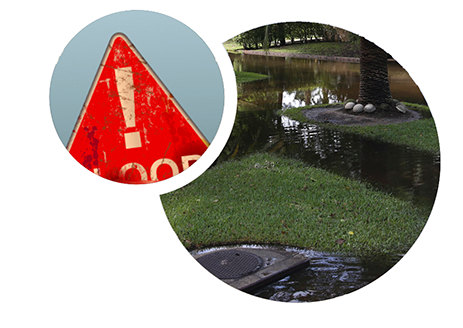Understanding Flood Alerts: A Comprehensive Guide

Table of Contents
Types of Flood Alerts and Their Meanings
Flood alerts are crucial warnings issued by meteorological agencies and emergency services to inform the public about the potential for or occurrence of flooding. Understanding the different types of alerts is vital for effective response.
Flood Watch
A flood watch means that conditions are favorable for flooding to occur. Heavy rainfall, rapid snowmelt, dam or levee failure, or a combination of these factors can trigger a flood watch. While flooding isn't imminent, it's important to monitor the situation closely and begin preparing.
- Prepare your flood emergency kit.
- Identify potential evacuation routes.
- Move valuable items to higher ground.
- Stay updated on weather forecasts and official warnings.
Flood Warning
A flood warning indicates that flooding is occurring or is imminent. This is a serious alert requiring immediate action. Flooding may already be affecting the area, and you may need to evacuate.
- Evacuate immediately if instructed to do so by authorities.
- Move to higher ground.
- Do not attempt to drive or walk through floodwaters.
- Contact emergency services if you need assistance.
Flood Emergency
A flood emergency signifies a life-threatening situation. Widespread and severe flooding is occurring, and immediate action is critical to survival.
- Evacuate immediately – this is a matter of life and death.
- Seek higher ground and follow instructions from emergency services.
- Contact emergency services for help.
- Listen to local radio or television for updates and instructions.
Other Alert Systems
Beyond the standard flood watch, warning, and emergency classifications, your local area may utilize additional alert systems. These might include specific river stage alerts, localized warnings based on geographic vulnerabilities, or integrated communication systems combining multiple alert types. Check with your local emergency management agency for details specific to your region.
Sources of Flood Alerts
Receiving timely and accurate flood alerts is paramount. Multiple sources offer crucial information, each playing a vital role.
National Weather Service (NWS) or Equivalent
The National Weather Service (NWS) in the US, or your country's equivalent meteorological agency, is the primary source for flood alerts.
- Websites: Regularly check the NWS website for weather alerts and forecasts specific to your location.
- Mobile Apps: Download the official NWS app or a similar weather app that provides real-time alerts and warnings.
- Social Media: Follow the NWS on social media platforms for timely updates.
The NWS provides reliable and credible information, ensuring you get the most accurate assessment of the flooding risk.
Local Emergency Management Agencies
Your local emergency management agency plays a vital role in disseminating flood alerts specific to your community.
- Sign up for local alert systems: Many communities offer reverse 911 or similar alert systems that send notifications directly to your phone.
- Local Government Websites: Consult your city or county government's website for emergency information and alerts.
- Community Meetings: Attend community meetings to learn about local flood preparedness plans.
By registering with multiple local channels, you ensure comprehensive flood alert coverage.
News Media
Reputable news outlets often provide flood alert updates, offering a complementary source of information.
- Trusted News Sources: Stick to established and reputable news organizations for reliable information.
- Verify Information: Cross-reference information from multiple sources to ensure accuracy and avoid misinformation.
While news media can provide valuable context, prioritize information from official government sources during emergencies.
Preparing for Floods Based on Flood Alerts
Proactive preparation is crucial for mitigating the impact of floods.
Developing a Family Emergency Plan
A well-defined plan is vital for efficient response during a flood emergency.
- Identify evacuation routes: Plan multiple escape routes from your home and know where to go if you need to evacuate.
- Establish a meeting point: Designate a location outside your home where your family can meet after evacuation.
- Create a communication strategy: Establish ways to contact each other if separated during a flood.
- Practice your plan: Regularly practice your family emergency plan to ensure everyone knows what to do in a flood emergency.
Creating a Flood Emergency Kit
A comprehensive emergency kit is essential for surviving a flood.
- Water: Store at least one gallon of water per person per day for several days.
- Food: Include non-perishable, easy-to-prepare food items.
- First-aid kit: Pack essential first-aid supplies and medications.
- Important documents: Keep copies of vital documents in a waterproof container.
- Flashlight and radio: Include battery-powered devices for communication and lighting.
Protecting Your Property
Taking steps to safeguard your property can significantly minimize flood damage.
- Flood insurance: Consider flood insurance to protect your financial assets.
- Elevate valuables: Move important items to higher levels of your home.
- Seal basement windows: Seal basement windows and doors to prevent water ingress.
- Clean gutters and drains: Regularly clean gutters and drains to prevent water buildup.
Conclusion: Staying Informed and Safe with Flood Alerts
Understanding and responding effectively to flood alerts is crucial for ensuring your safety and minimizing potential damage. By staying informed through multiple reliable sources, developing a family emergency plan, and taking proactive steps to protect your property, you can significantly improve your chances of weathering a flood. Remember to regularly check for flood alerts in your area and share this information with your friends and family. Stay informed about potential flood risks in your area by regularly checking for flood alerts and taking proactive steps to ensure your family's safety. Share this article to spread awareness and help others prepare for flood events.

Featured Posts
-
 Watch The Saint On Itv 4 A Comprehensive Guide To Broadcast Times
May 26, 2025
Watch The Saint On Itv 4 A Comprehensive Guide To Broadcast Times
May 26, 2025 -
 The Impact Of Canada Posts Performance On The Delivery Services Market
May 26, 2025
The Impact Of Canada Posts Performance On The Delivery Services Market
May 26, 2025 -
 Met Gala 2025 The Naomi Campbell And Anna Wintour Conflict Explained
May 26, 2025
Met Gala 2025 The Naomi Campbell And Anna Wintour Conflict Explained
May 26, 2025 -
 Moto Gp Argentina 2025 Di Trans7 Jadwal Tayang Lengkap
May 26, 2025
Moto Gp Argentina 2025 Di Trans7 Jadwal Tayang Lengkap
May 26, 2025 -
 Thierry Ardisson Tacle Laurent Baffie Essaie De Parler Pour Toi
May 26, 2025
Thierry Ardisson Tacle Laurent Baffie Essaie De Parler Pour Toi
May 26, 2025
